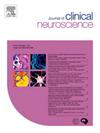Predictors of time to achieve clinically significant improvements following lateral lumbar interbody fusion
IF 1.9
4区 医学
Q3 CLINICAL NEUROLOGY
引用次数: 0
Abstract
Background
As lateral lumbar interbody fusions (LLIF) are increasingly performed, our understanding of postoperative clinical trajectories is important in informing preoperative patient expectations. While minimum clinically important difference (MCID) rates are widely utilized in spine surgery literature, there is less published on how long it takes for patients to achieve MCID following LLIF.
Objective
To evaluate the length of time it takes for patients to report MCID achievement for back pain, leg pain, disability, and physical function and evaluate predictors of time to achieve MCID.
Methods
Patients undergoing elective LLIF by the senior author with baseline and postoperative patient-reported outcomes (PROs) recorded were retrospectively identified. Data on potential predictors of time to MCID achievement were gathered including demographics, comorbidities, diagnostic information, and baseline PROs. MCID achievement rates for Oswestry Disability Index (ODI), Visual Analog Scale-Back (VAS-Back), VAS-Leg, and Patient-Reported Outcome Measurement Information System-Physical Function (PROMIS-PF) were calculated at six-, twelve, 6 month- 1 year- and 2-year postoperative timepoints. A Kaplan-Meier survival analysis was conducted to determine the proportion of patients achieving MCID at each time point. A multivariate Cox regression determined predictors of time to MCID achievement.
Results
One hundred-five patients were included in the analysis. The mean time to achieve MCID for PROMIS-PF was 44.7 weeks, for VAS-Back was 38.5 weeks, for VAS-Leg was 36.7 weeks, and for ODI was 38.3 weeks. Worse baseline VAS-Back significantly predicted earlier MCID achievement for VAS-Back (HR: 1.55), while diabetes was predictive of later MCID achievement (HR: 0.21). Higher body mass index and worse preoperative ODI predicted earlier MCID achievement for ODI (HR: 1.04–1.08), and higher VAS-Leg score and two-level fusion were predictive of later MCID achievement for ODI, (HR:0.26–0.81). Worse preoperative VAS-Leg, isthmic spondylolisthesis, and three-level fusion were predictors of earlier achievement of MCID for VAS-Leg (HR: 1.27–6.47). Herniated nucleus pulposus and foraminal stenosis were early predictors (HR: 2.92–3.23) and workers’ compensation was a late predictor of MCID attainment for PROMIS-PF (HR: 0.13).
Conclusion
Select demographic variables, comorbidities, spinal pathology, and preoperative PROs influenced the time it took for patients to report clinically significant improvements in pain, disability, and physical function scores. These findings can be used to prognosticate outcomes for patients undergoing LLIF and inform patient expectations of postoperative recovery.
腰椎侧位椎体间融合术后临床症状明显改善所需时间的预测因素。
背景:随着腰椎侧位椎体间融合术(LLIF)的实施越来越多,我们对术后临床轨迹的了解对于告知患者术前期望非常重要。虽然脊柱手术文献中广泛使用最小临床重要差异(MCID)率,但关于患者在 LLIF 术后多久才能达到 MCID 的文献却较少:目的:评估患者报告腰痛、腿痛、残疾和身体功能达到 MCID 所需的时间长度,并评估达到 MCID 所需的时间预测因素:方法:对资深作者进行的选择性 LLIF 患者进行回顾性鉴定,记录患者报告的基线和术后结果 (PRO)。收集了MCID达标时间潜在预测因素的数据,包括人口统计学、合并症、诊断信息和基线PROs。计算了术后 6 个月、12 个月、6 个月-1 年和 2 年时间点的 Oswestry 失能指数 (ODI)、视觉模拟量表-背 (VAS-背)、视觉模拟量表-腿 (VAS-Leg) 和患者报告结果测量信息系统-身体功能 (PROMIS-PF) 的 MCID 达标率。卡普兰-梅耶生存分析确定了在每个时间点达到 MCID 的患者比例。多变量考克斯回归确定了达到 MCID 时间的预测因素:分析共纳入了 15 名患者。PROMIS-PF达到MCID的平均时间为44.7周,VAS-Back为38.5周,VAS-Leg为36.7周,ODI为38.3周。基线VAS-Back较差可显著预测VAS-Back较早达到MCID(HR:1.55),而糖尿病可预测较晚达到MCID(HR:0.21)。较高的体重指数和较差的术前 ODI 预测较早达到 ODI 的 MCID 指标(HR:1.04-1.08),较高的 VAS-Leg 评分和两级融合预测较晚达到 ODI 的 MCID 指标(HR:0.26-0.81)。术前较差的 VAS-Leg、峡部脊柱滑脱和三水平融合是较早达到 VAS-Leg MCID 的预测因素(HR:1.27-6.47)。髓核突出和椎间孔狭窄是早期预测因素(HR:2.92-3.23),而工伤是PROMIS-PF达到MCID的晚期预测因素(HR:0.13):结论:选定的人口统计学变量、合并症、脊柱病理和术前PROs会影响患者报告疼痛、残疾和身体功能评分临床显著改善所需的时间。这些发现可用于预测接受 LLIF 治疗的患者的预后,并告知患者对术后恢复的期望。
本文章由计算机程序翻译,如有差异,请以英文原文为准。
求助全文
约1分钟内获得全文
求助全文
来源期刊

Journal of Clinical Neuroscience
医学-临床神经学
CiteScore
4.50
自引率
0.00%
发文量
402
审稿时长
40 days
期刊介绍:
This International journal, Journal of Clinical Neuroscience, publishes articles on clinical neurosurgery and neurology and the related neurosciences such as neuro-pathology, neuro-radiology, neuro-ophthalmology and neuro-physiology.
The journal has a broad International perspective, and emphasises the advances occurring in Asia, the Pacific Rim region, Europe and North America. The Journal acts as a focus for publication of major clinical and laboratory research, as well as publishing solicited manuscripts on specific subjects from experts, case reports and other information of interest to clinicians working in the clinical neurosciences.
 求助内容:
求助内容: 应助结果提醒方式:
应助结果提醒方式:


